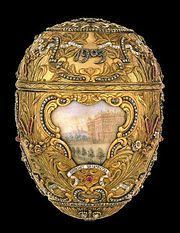Year delivered 1903 Year of acquisition 1947 | ||
 | ||
Similar Pelican, Alexander Palace, Imperial Coronation Egg, Moscow Kremlin, Rose Trellis | ||
Peter, the Great Egg, is a jewelled Easter egg made under the supervision of the Russian jeweler Peter Carl Fabergé in 1903, for the last Tsar of Russia, Nicholas II. Tsar Nicholas presented the egg to his wife, the Czarina Alexandra Fyodorovna. The egg is currently located at the Virginia Museum of Fine Arts in Richmond, Virginia, in the United States.
Contents
Design
Made in the Rococo style, the Peter the Great Egg celebrated the two-hundredth anniversary of the founding of St. Petersburg in 1703. It is made of red, green and yellow gold, platinum, rose-cut diamonds, rubies, enamel, rock crystal, and miniature watercolor portraits on ivory.The egg measures 4 1⁄4 by 3 1⁄8 (diameter) inches.
Executed in gold, the curves are set with diamonds and rubies. The body of the egg is covered in laurel leaves and bulrushes that are chased in 14-carat green gold. These symbolize the source of the "living waters". The spikyheads are set with square rubies. White enamel ribbons inscribed with historical details encircle the egg. On the top of the egg is an enameled wreath which encircles Nicholas II's monogram. The bottom of the egg is adorned with the double-headed imperial eagle, made of black enamel and crowned with two diamonds.
The egg shell features four miniature watercolors painted by B. Byalz. The paintings representing the "before" and "after" of St. Petersburg in 1703 and 1903. The front painting features the extravagant Winter Palace, the official residence of Nicholas II two hundred years after the founding of St. Petersburg. Opposite this, on the back of the egg, is a painting of the log cabin believed to be built by Peter the Great himself, representative of the founding of St. Petersburg on the banks of the Neva River. On the sides of the egg are portraits of Peter the Great in 1703 and Nicholas II in 1903. Each of the miniatures is covered by rock crystal. The dates 1703 and 1903, worked in diamonds, appear on either side of the lid above the paintings of the log cabin and Winter Palace, respectively.
Below each painting are fluttering enamel ribbons with inscriptions in black Cyrillic letters. The inscriptions include: "The Emperor Peter the Great, born in 1672, founding St. Petersburg in 1703", "The first little house of the Emperor Peter the Great in 1703", "The Emperor Nicholas II born in the 1868 ascended the throne in 1894" and "The Winter Palace of His Imperial Majesty in 1903."
Surprise
The surprise is that when the egg is opened, a mechanism within raises a miniature gold model of Peter the Great's monument on the Neva, resting on a base of sapphire. The model was made by Gerogii Malychevin. The reason for this choice of surprise is the story of a legend from the 19th century that says enemy forces will never take St. Petersburg while the "Bronze Horseman" stands in the middle of the city.
History
St. Petersburg was founded by Peter the Great in 1703 during the Great Northern War. Peter moved the Russian capital from Moscow to St. Petersburg and intended the new city to be a "window on the west," in an effort to Westernize Russia. St. Petersburg became a European cultural center and continues to be the most westernized city in Russia.
The Peter the Great Egg was sold in 1930 to Armand Hammer, an American entrepreneur who had business interests in Russia. It was later bought by A la Vieille Russie, New York City. In 1944 it was purchased by Lillian Pratt of Fredericksburg, Virginia (1876–1947) and bequeathed to the Virginia Museum of Fine Arts in 1947. It remains on permanent view in their European Decorative Art Collection.
